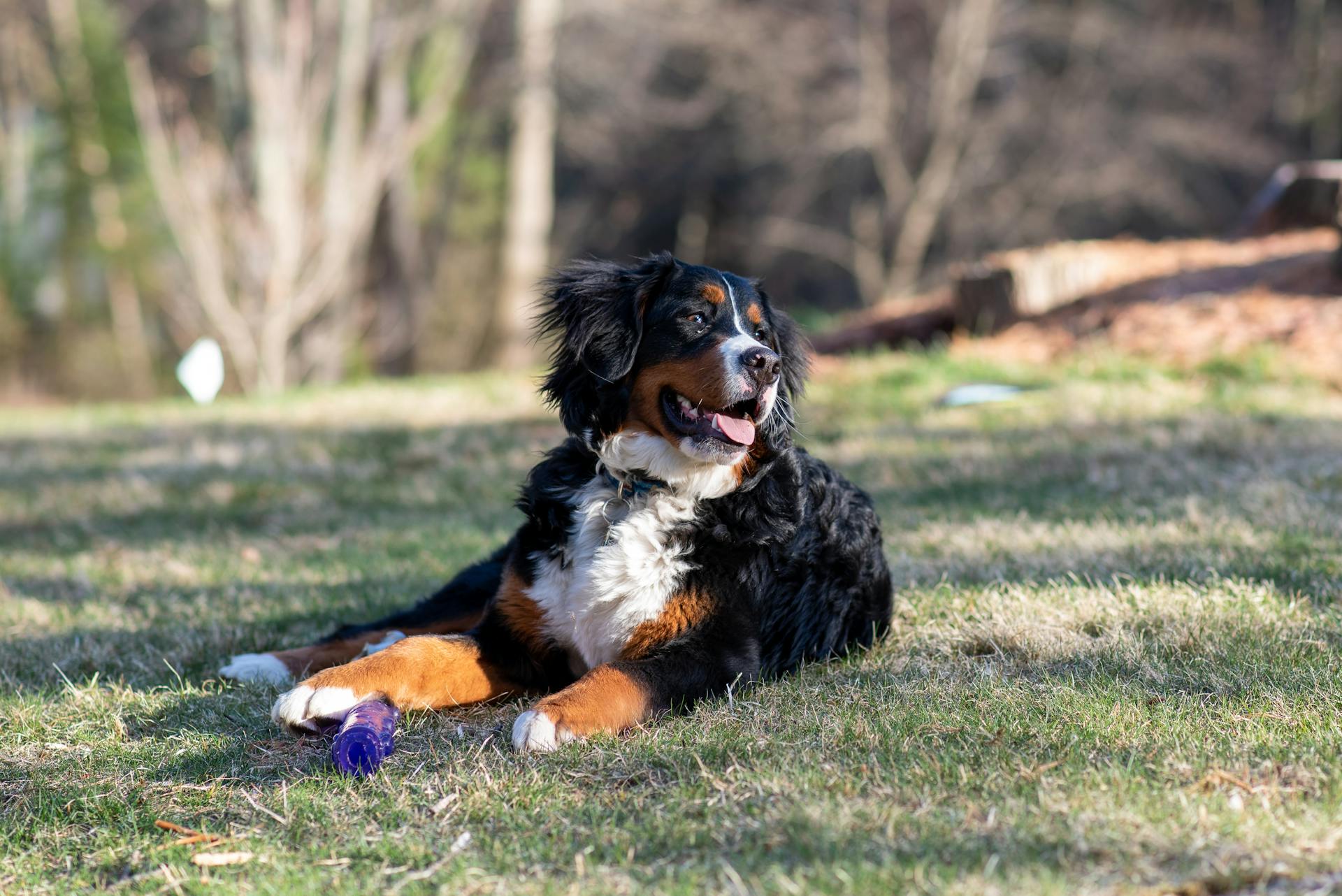
Histiocytosis in Bernese Mountain Dogs is a serious condition that requires prompt attention.
The symptoms of histiocytosis in Bernese Mountain Dogs can be subtle at first, but can progress rapidly if left untreated.
Bernese Mountain Dogs affected by histiocytosis may experience weight loss, lethargy, and a poor appetite.
In severe cases, histiocytosis can lead to organ damage and even death.
Recommended read: Dogs like Bernese Mountain Dog
What is Histiocytosis?
Histiocytosis is a group of rare disorders that affect the body's immune system.
It's characterized by the abnormal proliferation of histiocytes, a type of immune cell that plays a key role in the body's defense against infection.
Histiocytes are a type of white blood cell that helps to fight off infections and foreign substances.
In histiocytosis, the histiocytes become activated and start to multiply excessively, leading to the accumulation of these cells in various parts of the body.
This can cause a range of symptoms, from mild to severe, depending on the type and location of the histiocytosis.
The most common types of histiocytosis are Langerhans cell histiocytosis (LCH) and non-Langerhans cell histiocytosis (NLCH).
LCH is more common in children, while NLCH tends to affect adults.
In dogs, histiocytosis can manifest in different ways, including cutaneous histiocytosis, which affects the skin, and systemic histiocytosis, which affects multiple organs.
Symptoms and Diagnosis
Symptoms of histiocytosis in Bernese Mountain Dogs can vary depending on the type of the disease. Nodular lesions of various sizes can appear anywhere on the body, often on the extremities, scrotum, mucous membranes, nose, and eyelids.
Lesions can be smooth, hairless, ulcerous, or crusted, and may be up to 4 centimeters in size. In some cases, the lesions may clear up on their own, but in others, they can be randomly recurring.
Systemic signs can include decreased appetite, weight loss, and enlarged lymph nodes. In some cases, the disease can also affect internal organs, such as the lung, liver, spleen, and bone marrow.
Here are some common symptoms of histiocytosis in Bernese Mountain Dogs:
- Nodular lesions of various sizes
- Appetite loss
- Swelling of the inner eye
- Inflammation or edema
- Swollen lymph nodes
- Muscle spasms
- Depression
A veterinarian will typically perform a physical examination to check for signs of lesions, and may also take a fine needle aspiration of the tumors or lesions for microscopic examination.
Histiocytic Sarcoma
Histiocytic sarcoma is a rare and aggressive type of cancer that affects the body's immune system. It's characterized by the abnormal growth of a specific type of immune cell called histiocytes.
Symptoms of histiocytic sarcoma can vary depending on the location and type of tumor, but common signs include fever, weight loss, and fatigue. These symptoms can be similar to those of other diseases, making diagnosis challenging.
Histiocytic sarcoma can occur in any part of the body, but it most commonly affects the lymph nodes, spleen, and bone marrow. In some cases, the tumor can spread to other organs, such as the liver, lungs, and brain.
Diagnosing histiocytic sarcoma requires a combination of imaging tests, such as CT scans and MRIs, and biopsies to examine tissue samples. A definitive diagnosis is often made after a thorough examination of the biopsy results.
Readers also liked: Histiocytic Sarcoma Bernese Mountain Dog
Symptoms

Symptoms of histiocytosis in dogs can vary depending on the type of the disease. The clinical signs can be very similar to each other, but some may involve more severe symptoms.
Lesions typically appear as multiple, red plaques or nodules anywhere on the body. They can be ulcerated, but are usually not painful or itchy.
Some dogs have lesions that remain confined to the nose, resulting in a "clown-nose" appearance. Nodules may wax and wane, or regress and then appear elsewhere on the body.
Systemic histiocytosis can cause a range of symptoms, including decreased appetite, weight loss, and enlarged lymph nodes. The course of the disease can vary, and signs may wax and wane, or be rapidly progressive and fatal.
Here are the symptoms of canine cutaneous histiocytoma (CCH) and cutaneous histiocytosis (CH):
- Nodular lesions of various sizes that can be up to 4 centimeters, smooth, hairless, ulcerous, or crusted.
- Lesions are distributed anywhere on the body, most common in extremities, scrotum, mucous membranes, nose, and eyelids.
- In CCH, the lesions usually clear up on their own.
- CH tumors come and go randomly.
Additional symptoms of CH and SH include appetite loss, swelling of the inner eye, inflammation or edema, swollen lymph nodes, muscle spasms, and depression.
Diagnosis

Diagnosis involves a thorough physical examination of your dog by the veterinarian, who will check vitals and look for signs of lesions from head to tail.
The veterinarian will also ask you to bring your dog's medical records, if possible, and inform them of any medications your pet is currently taking.
Fine needle aspiration of the tumors or lesions is often taken for microscopic examination to help with diagnosis.
Some diagnostic tests may reveal low hemoglobin and iron reserves, leading to anemia, as well as a low number of platelets and increased liver enzymes.
Radiography, or x-rays, can give the veterinarian an idea of how far the disease has spread.
Frequently Asked Questions
What cancer is most common in Bernese Mountain dogs?
Bernese Mountain Dogs are prone to Histiocytosis, a cancer that can be fatal if left untreated. Understanding the risks and genetics of this disease is crucial for responsible breeding and pet care.
What are the symptoms of systemic histiocytosis in dogs?
Systemic histiocytosis in dogs can cause a range of symptoms, including weight loss, decreased appetite, and swollen lymph nodes. Nodules may also appear on the eyelids and nasal mucosa, indicating the severity of the disease
What is the life expectancy of a dog with malignant histiocytosis?
Malignant histiocytosis in dogs typically has a poor prognosis, with death often occurring within weeks to months of diagnosis. The aggressive nature of this cancer makes treatment challenging and life expectancy limited.
What causes histiocytosis in dogs?
Histiocytosis in dogs is often caused by an immune system dysfunction triggered by persistent antigenic stimulation, although the exact cause is often unknown. Further research is needed to determine the underlying factors contributing to this condition.
Sources
- https://animalallergycolorado.com/animal-disease-index/reactive-histiocytosis
- https://hospital.cvm.ncsu.edu/services/small-animals/cancer-oncology/oncology/canine-histiocytic-sarcoma/
- https://wagwalking.com/condition/histiocytosis
- https://www.ethosvet.com/blog-post/histiocytic-sarcoma/
- https://www.mdpi.com/2306-7381/3/1/2
Featured Images: pexels.com

